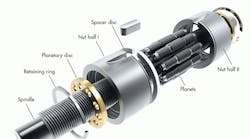This file type includes high-resolution graphics and schematics when applicable.
Power density is one of the primary reasons why design engineers and manufacturers rely on hydraulics when they want their machines to move something. Hydraulic systems offer very high force density in a compact, relatively economical design. But inherent drawbacks to hydraulics are leading design engineers and manufacturers to consider an electromechanical system as an alternative to its hydraulic counterpart. One way to do this is by replacing the hydraulic cylinder with an actuator and screw driven by an electric motor.
The roller screw’s ability to generate two to five times the force of an equivalent ball screw makes it an excellent replacement for a hydraulic system. However, due to the precise grinding tolerances needed to achieve the load-sharing properties, roller screws can be expensive. To address this issue, Schaeffler recently developed the PWG differential roller screw, which offers the high forces of a traditional roller screw at a price point closer to that of a ball screw.
The key to the PWG’s affordability is Schaeffler’s ability to manufacture its spindle and planet gears by forming (rolling), rather than undergo the time-consuming and expensive grinding process typically used to manufacture traditional roller screws.
Schaeffler’s PWG is characterized by very high power density. The PWG’s large number of contact points between the planets and spindle enable it to achieve very high axial load-carrying capacity. Applications for the PWG include power tools, sheet-metal bending machines, locking cylinders for plastic-injection-molding machines, and riveting and cutting devices. The PWG is currently in volume-production use in automotive clutch actuators.



